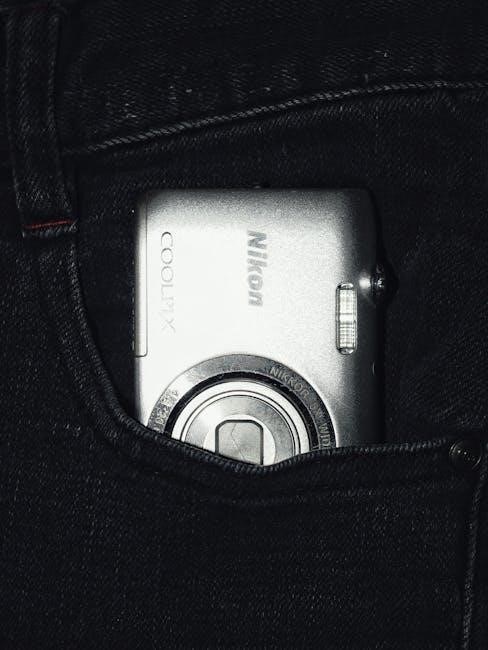Pocket hole screws are a revolutionary joinery method in woodworking, offering strength and simplicity. They create hidden joints, ideal for DIY projects and professional carpentry. Kreg Tools leads in providing reliable solutions for this technique, which has gained popularity due to its efficiency and versatility in various woodworking applications.
1.1 What Are Pocket Hole Screws?
Pocket hole screws are specialized fasteners used in woodworking to create strong, hidden joints. They consist of a coarse thread for gripping wood and a sharp point for easy insertion. Unlike traditional screws, they are designed to be driven at an angle into a pre-drilled pocket hole, allowing for flush joints and invisible connections. This method is ideal for DIY projects, furniture making, and home improvement tasks. Kreg Tools, a leader in this field, offers innovative solutions for pocket hole joinery, making it accessible to woodworkers of all skill levels. The technique is celebrated for its efficiency and versatility.
1.2 History and Evolution of Pocket Hole Screws
The concept of pocket hole screws dates back to traditional woodworking techniques, but modern versions were popularized in the late 20th century. Kreg Tools revolutionized the method with their portable jig, making it accessible to DIY enthusiasts and professionals alike. Over time, advancements in materials and design have improved the durability and ease of use of these screws. Today, they are a staple in woodworking, offering a reliable alternative to dowels, biscuits, and other joinery methods. Their evolution reflects the ongoing innovation in woodworking tools and techniques, driven by companies like Kreg Tools.
1.3 Importance of Pocket Hole Screws in Woodworking
Pocket hole screws have become a cornerstone in woodworking due to their exceptional strength and versatility. They provide a hidden, durable joint, making them ideal for both functional and decorative projects. Unlike traditional methods like dowels or biscuits, pocket hole screws simplify the process, allowing for quick and precise connections. This technique is particularly valued in DIY and professional settings, as it enhances productivity without compromising quality. Their popularity continues to grow, as they offer a reliable and efficient solution for a wide range of woodworking applications, making them a go-to choice for many woodworkers.

Tools and Materials Needed for Pocket Hole Screws
- Kreg pocket hole jig for precise drilling.
- Drill and driver for screw insertion.
- Clamps to secure the workpiece.
- Wood glue for added joint strength.
2.1 Essential Tools: Drill, Jig, and Driver
The drill, jig, and driver are the cornerstone tools for pocket hole screws. A drill creates the pilot hole, while the jig ensures precise alignment and depth. The driver securely fastens the screw. Together, these tools enable strong, hidden joints, making them indispensable for woodworking projects. Kreg Tools, a trusted brand, offers high-quality jigs like the Kreg 520 Pro, designed for efficiency and accuracy. These tools simplify the process, allowing woodworkers to achieve professional results without complex setups. Their versatility and reliability make them a favorite among DIY enthusiasts and professionals alike, streamlining the joinery process for various woodworking tasks.
2.2 Types of Pocket Hole Jigs Available
Pocket hole jigs come in various styles to suit different needs and skill levels. Kreg Tools offers a range of models, from basic to advanced, such as the Kreg 520 Pro, known for its speed and precision. These jigs are designed to create consistent and accurate pocket holes, ensuring strong joints. Whether you’re a DIY enthusiast or a professional, there’s a jig available to match your project’s demands. The variety of options allows woodworkers to choose the right tool for their specific needs, enhancing both efficiency and results in woodworking projects.
2.3 Recommended Materials for Best Results
For optimal performance with pocket hole screws, it’s essential to use high-quality materials. Solid wood, medium-density fiberboard (MDF), and plywood are ideal choices. Kreg screws, known for their durability, are specifically designed for these applications. Ensure the wood is dry and free of imperfections to avoid splitting. Using the correct drill bits and settings with your jig will also enhance results. Proper material selection and preparation are crucial for achieving strong, long-lasting joints in your woodworking projects.

Step-by-Step Guide to Using Pocket Hole Screws
Learn to master pocket hole screws with a simple, efficient process. Start by preparing the wood, then set up your jig accurately. Finally, drill the pocket hole and drive the screw for a strong, hidden joint. Using tools like the Kreg 520 Pro jig ensures precision and speed, making your woodworking projects easier and more professional.
3.1 Preparing the Wood for Drilling
Preparing the wood is crucial for successful pocket hole drilling. Start by measuring and marking the wood where the screws will be placed. Clamp the wood securely to prevent movement during drilling. Ensure the surface is flat and free from debris. Lightly sanding the area can help the drill bit grip better. Always align the wood grain correctly to avoid splitting. Use a pencil to clearly mark the drill points for accuracy. Proper preparation ensures clean, precise pocket holes and strong joints. For best results, use high-quality wood and tools, such as those recommended by Kreg Tools, to achieve professional-grade outcomes.
3.2 Setting Up the Pocket Hole Jig Correctly
Setting up the pocket hole jig correctly is essential for precise and professional results. Begin by clamping the jig firmly to your workbench or the wood itself to ensure stability. Adjust the jig to match the thickness of your material, typically between 1/2″ to 1-1/2″ for most projects. Align the drill guide with the marked points on the wood, ensuring proper spacing and alignment for strong joints. Double-check that the drill bit is set to the correct depth to avoid over-drilling. Proper setup prevents errors and ensures the screws will hold securely. Always refer to the manufacturer’s guidelines, such as those provided by Kreg Tools, for optimal performance.
3.3 Drilling the Pocket Hole and Driving the Screw
Drilling the pocket hole and driving the screw are the final steps in securing your joint. Use the drill bit provided with your jig to create the pilot hole at the marked location. Ensure the drill is perpendicular to the wood to avoid angled holes; Once the hole is drilled, insert the screw through the pilot hole and into the adjoining piece of wood. Use a screwdriver or an electric drill with a screwdriver bit to drive the screw firmly until it is flush with the surface. Avoid over-tightening, as this could cause the wood to split. Kreg Tools recommends using their specialized bits for precise results. Proper alignment and technique ensure a strong, durable joint.

Best Practices for Working with Pocket Hole Screws
Best practices ensure strong, durable joints. Always use the correct screw type and length for your material. Maintain proper alignment to avoid weak connections and ensure screws are driven flush with the surface for a professional finish. Kreg Tools recommends using their specialized bits for consistent results. Regularly inspect and maintain your jig for accuracy, and avoid over-tightening screws to prevent splitting the wood. Following these guidelines enhances the reliability and appearance of your projects.
4.1 Choosing the Right Screw Length and Type
Choosing the right screw length and type is critical for strong joints. Screw length should be sufficient to secure the material without over-penetrating. As a rule, screws should be at least half the thickness of the thickest material being joined. Coarse-thread screws are ideal for softwoods, while fine-thread screws work best with hardwoods. Always select screws designed for your specific material to ensure proper hold and avoid splitting. For most projects, 1-1/4” screws are standard, but thicker materials may require longer options. Use a screw length chart or consult manufacturer guidelines for precise recommendations. Proper selection enhances joint strength and durability.
4.2 Ensuring Proper Alignment for Strong Joints
Proper alignment is essential for creating strong, durable joints. Misaligned screws can lead to weak connections or project failure. Use a pocket hole jig to guide the drill bit accurately, ensuring screws are driven straight. Clamp workpieces together before drilling to prevent shifting. Align the jig with the edge of the material using a square or straightedge. This ensures the screw enters at the correct angle. Proper alignment distributes stress evenly across the joint, enhancing overall strength. Take your time to double-check alignment before drilling—accuracy here is key to a professional-grade finish and long-lasting results.
4.3 Tips for Avoiding Splitting the Wood
Avoiding wood splitting is crucial for clean, professional results. Always pre-drill pilot holes using the jig’s guide to prevent the screw from forcing a split. Use the correct drill bit size for your screws to avoid over-stressing the wood. For hardwoods or thin materials, consider drilling slightly deeper pockets. Apply steady, consistent pressure while drilling to maintain control. Avoid over-tightening screws, as this can exert excessive force on the surrounding wood. Using a backing board or clamping the workpiece firmly can also help distribute pressure evenly, reducing the risk of splits and ensuring a secure, durable joint;

Common Mistakes to Avoid When Using Pocket Hole Screws
Common mistakes when using pocket hole screws can weaken joints and damage wood. Avoiding errors ensures strong, durable connections. Proper technique and attention to detail are key.
5.1 Over-Tightening the Screw
Over-tightening pocket hole screws is a common mistake that can lead to stripped holes, split wood, or weakened joints. This often occurs when excessive force is applied, especially in softer materials. To avoid this, use a torque-controlled drill or monitor the screw as it seats. Stop driving once the screw head is flush with the wood surface. Over-tightening can also damage the surrounding material, making the joint less secure. Always check the screw depth and avoid applying unnecessary pressure to ensure a strong, durable connection without compromising the wood integrity or the screw’s effectiveness.
5.2 Incorrect Drill Bit Angle
Drilling pocket holes at an incorrect angle can lead to misaligned screws and weakened joints. Always ensure the drill bit is perfectly perpendicular to the wood surface. Using a pocket hole jig helps maintain the correct angle, but double-checking before drilling is essential. If the angle is off, the screw may not seat properly, causing the joint to shift or the wood to split. To avoid this, align the jig carefully and verify the drill bit’s angle with a carpenter’s square or built-in jig guide. Proper alignment ensures strong, precise connections and prevents costly mistakes in your woodworking projects.
5.3 Not Using the Correct Screw for the Material
Using the wrong screw for your material can compromise joint strength and durability. Pocket hole screws come in various types, such as coarse-thread for softwoods and fine-thread for hardwoods or sheet goods. Using a screw designed for a different material can lead to poor hold, stripping, or even wood splitting. Always match the screw type to your material for optimal results. Consult the manufacturer’s guidelines or a woodworking guide to ensure compatibility. This simple step ensures stronger, more reliable joints and prevents avoidable project failures.

When to Use Pocket Hole Screws
Pocket hole screws are ideal for projects requiring strong, hidden joints, such as furniture, shelving, or cabinetry. They excel in creating flush surfaces and are versatile for various wood types.
6.1 Ideal Projects for Pocket Hole Joinery
Pocket hole joinery is perfect for projects requiring strong, hidden joints, such as building tables, shelves, cabinets, and chairs. It’s ideal for creating flush surfaces and aligning wood seamlessly. DIY furniture, custom shelving units, and wooden frames benefit greatly from this method. Additionally, pocket hole screws are excellent for assembling decking, outdoor planters, and other woodworking tasks where durability is key. Their ability to handle various wood types and thicknesses makes them versatile for both small and large-scale projects, ensuring professional-looking results with minimal effort.
6.2 Alternatives to Pocket Hole Screws
While pocket hole screws are highly effective, there are alternative methods for joining wood. Standard wood screws, for instance, provide strong connections but lack the concealed finish of pocket holes. Dowels and biscuits are popular for creating invisible joints, though they require precise alignment. The Festool Domino system offers a fast and accurate alternative, ideal for complex projects. Traditional mortise and tenon joints are another option, offering exceptional strength for heavy-duty applications. Each method has its own advantages, and the choice depends on the desired outcome, project complexity, and the tools available. Exploring these alternatives can expand your woodworking capabilities.
6.3 Situations Where Pocket Hole Screws Are Not Recommended
Pocket hole screws may not be the best choice in certain scenarios. For very thin wood, they can cause splitting or weaken the material. In load-bearing applications requiring extreme strength, alternative methods like mortise and tenon or metal brackets might be more suitable. Additionally, for fine furniture or projects where visible screws are undesirable, traditional joinery techniques are often preferred. In situations involving repeated stress or heavy weight, such as outdoor furniture exposed to harsh conditions, other fastening methods may provide better durability. Understanding these limitations helps in choosing the most appropriate fastening solution for the project.

Advanced Techniques with Pocket Hole Screws
Explore creative and specialized methods to enhance your projects, including reinforcing joints, working with thick materials, and innovative applications beyond traditional woodworking.
7.1 Reinforcing Joints with Plugs or Fillers
Reinforcing joints with plugs or fillers adds strength and visual appeal to pocket hole connections. Wood plugs, matched to the material, are inserted into the pocket hole and sanded flush for a seamless look. Epoxy fillers can also be used for added durability and resistance. This method is particularly effective in load-bearing projects or when the joint will be visible. Properly sealed and finished, these reinforcements enhance both the structural integrity and aesthetic quality of the piece. This technique is ideal for fine woodworking and custom furniture-making projects where precision and strength are paramount. It ensures a professional finish every time.
7.2 Using Pocket Hole Screws in Thick or Hardwoods
Working with thick or hardwoods, like oak or maple, requires adjustments when using pocket hole screws. Hardwoods are denser, so pre-drilling and using a sharp drill bit are crucial to avoid splitting. For thicker materials, ensure the screw length is adequate to secure the joint without over-extending. Using a backing board or clamping firmly can help prevent splitting. High-quality screws with a coarse thread are ideal for hardwoods, as they provide better grip. Always maintain proper clamping pressure and drive screws slowly to ensure accurate placement and avoid mistakes. This ensures strong, reliable joints even in challenging materials.
7.3 Creative Applications Beyond Basic Joinery
Pocket hole screws can be used creatively beyond traditional woodworking joinery. For instance, they can be incorporated into furniture design as decorative elements or to create hidden compartments. Craftsmen often use them to attach removable panels or to create rotating mechanisms, such as swivel table sections. Additionally, pocket hole screws can be used to mount hardware like hinges or handles securely. These screws are also ideal for constructing custom storage solutions or intricate cabinetry. By thinking outside the box, woodworkers can leverage pocket hole screws to add functionality and aesthetic appeal to their projects, showcasing their versatility in modern woodworking designs.

Safety Tips and Precautions
Ensure safety by wearing protective gear, maintaining a clean workspace, and handling tools with care. Regular inspections and proper storage prevent accidents and injuries. Stay alert and avoid distractions.
8.1 Proper Safety Gear and Workspace Setup
Always wear safety glasses, gloves, and a dust mask to protect against debris and dust. Ensure the workspace is well-lit, clear of clutter, and free from tripping hazards. Keep sharp tools and power equipment well-maintained to prevent accidents. Secure the workpiece firmly to prevent movement during drilling or driving screws. Maintain good ventilation to avoid inhaling sawdust. Avoid loose clothing or long hair that could get caught in tools. Ensure proper footing and avoid overreaching. Keep a first aid kit nearby and stay alert to prevent mishaps. A safe setup ensures a smooth and injury-free project experience.
8.2 Handling Sharp Objects and Power Tools
Always handle sharp objects and power tools with care to minimize risks. Keep drill bits, screws, and other sharp items in a secure container when not in use. Avoid touching blade edges or points. Use a firm grip when handling power tools, and ensure they are properly powered off before adjusting or storing. Never leave running tools unattended. Regularly inspect tools for damage or wear, and replace them if necessary. Keep children and pets away from sharp objects and power tools. Proper handling prevents accidents and ensures safe operation during pocket hole projects.
8.3 Preventing Accidents in the Workshop
Preventing accidents in the workshop requires a proactive approach. Always keep the workspace clean and well-lit to avoid tripping hazards. Use tool guards and ensure proper ventilation. Store materials and tools securely to prevent accidental falls. Wear appropriate PPE, such as safety glasses and gloves, when operating power tools. Avoid loose clothing or long hair that could get caught in machinery. Follow manufacturer guidelines for tool usage and inspect equipment regularly for damage. Never work when fatigued or distracted. Keep emergency supplies, like a first aid kit, readily available. A safe workshop environment minimizes risks and ensures successful pocket hole projects.

Maintenance and Care of Pocket Hole Jigs
Clean and lubricate moving parts regularly. Store in a dry place to prevent rust. Check for wear and replace parts as needed. Proper alignment ensures accuracy. These practices extend the jig’s lifespan and ensure consistent results.
9.1 Cleaning and Storing the Jig
Regular cleaning is essential to maintain the jig’s precision. Use a soft brush or cloth to remove dust and debris. For tougher residue, dampen the cloth with mild detergent, but avoid submerging the jig. Allow it to dry completely before storing. Store the jig in a protective case or dry place to prevent rust and damage; If storing for extended periods, apply a light layer of silicone-based lubricant to moving parts. Proper storage ensures the jig remains accurate and functional for future projects. Clean and store after each use to preserve its condition and performance.
9.2 Replacing Worn or Damaged Parts
Regularly inspect the jig for wear or damage, such as bent drill guides or loose clamps. Replace parts immediately if they compromise accuracy. Most jigs come with interchangeable components, like drill bushes or clamp pads, which can be purchased from the manufacturer. Ensure replacement parts match the jig’s specifications for proper fit and function. Refer to the user manual for guidance on disassembly and installation. Using genuine or compatible parts prevents misalignment and ensures consistent results. Avoid using a damaged jig, as it can lead to inaccurate pocket holes and weaker joints. Always test the jig after replacement to confirm proper operation.
9.3 Calibrating the Jig for Accuracy
Calibrating your pocket hole jig ensures precise drill guide alignment and consistent results. Start by consulting the manufacturer’s guide for specific instructions, as models may vary. Loosen any adjustment screws and position the jig on a flat, stable surface. Use a reference, like a square or caliper, to align the drill guide with the edge of the workpiece. Tighten the screws firmly to secure the adjustment. For optimal accuracy, recalibrate the jig periodically or after replacing parts. Always test the jig on scrap wood to confirm proper alignment before starting your project. Regular calibration ensures strong, precise joints every time.
Pocket hole screws offer versatility, ease of use, and strong joints, making them ideal for various woodworking projects. With proper techniques and tools, you can achieve professional results effortlessly. Start your next project with confidence and create durable, long-lasting pieces. The convenience and reliability of pocket hole screws make them an essential tool for any woodworker.
10.1 Summary of Key Points
Pocket hole screws are a versatile and efficient fastening solution in woodworking, offering strong, hidden joints with minimal effort. Essential tools like drills, jigs, and drivers are crucial for precise results. Proper techniques, such as maintaining alignment and avoiding over-tightening, ensure durability. Selecting the right screw type and length is vital for material compatibility. Regular maintenance of jigs and safety precautions enhance workflow. While pocket hole screws excel in many projects, they may not suit all materials or thicknesses. By mastering these tips, woodworkers can unlock the full potential of pocket hole joinery for professional-grade outcomes.
10.2 Encouragement to Start Your Next Project
With the knowledge and techniques outlined in this guide, you’re now equipped to tackle your next woodworking project with confidence. Pocket hole screws simplify the process of creating sturdy, professional-grade joints, making even complex projects achievable. Whether you’re building furniture, shelving, or cabinets, this method ensures precision and strength. Don’t hesitate to experiment and apply these skills to your creative ideas. Start small, practice your technique, and watch your projects flourish. The versatility of pocket hole screws opens endless possibilities, so gather your tools and materials, and let your next creation take shape!

10.3 Final Thoughts on the Versatility of Pocket Hole Screws
Pocket hole screws offer unparalleled versatility in woodworking, making them an essential tool for both beginners and experienced craftsmen. Their ability to create strong, hidden joints in various materials, from softwoods to hardwoods, ensures durability and a clean finish. Whether you’re building furniture, cabinets, or shelving, these screws adapt seamlessly to your project’s needs. Their strength and simplicity make them a go-to solution for achieving professional results. Embrace their flexibility and explore the endless possibilities they bring to your workshop, elevating your creations with precision and reliability.